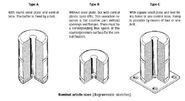A buffer is a device designed to stop a descending car or counterweight beyond its normal limit and to soften the force with which the elevator runs into the pit during an emergency. They may be of polyurethane or oil type in respect of the rated speed.
There are two principal types of buffers in existence:
- Energy accumulation: accumulate the kinetic energy of the car or counterweight.
- Energy dissipation: dissipate the kinetic energy of the car or counterweight.
Main types of elevator buffers
Polyurethane buffer
Polyurethane buffers which are energy accumulation type with non-linear characteristics are used for lifts that have rated speed not more than 1 m/sec. Polyurethane buffers have three shapes as shown in the below image.
Spring buffer
A spring buffer is one type of buffer most commonly found on hydraulic elevators or used for elevators with speeds less than 200 feet per minute. These devices are used to cushion the elevator and are most always located in the elevator pit.
Oil buffer
An oil buffer is another type of buffer more commonly found on traction elevators with speeds higher than 200 feet per minute. This type of buffer uses a combination of oil and springs to cushion a descending car or counterweight and are most commonly located in the elevator pit, because of their location in the pit buffers have a tendency to be exposed to water and flooding. They require routine cleaning and painting to assure they maintain their proper performance specifications. Oil buffers also need their oil checked and changed if exposed to flooding.


